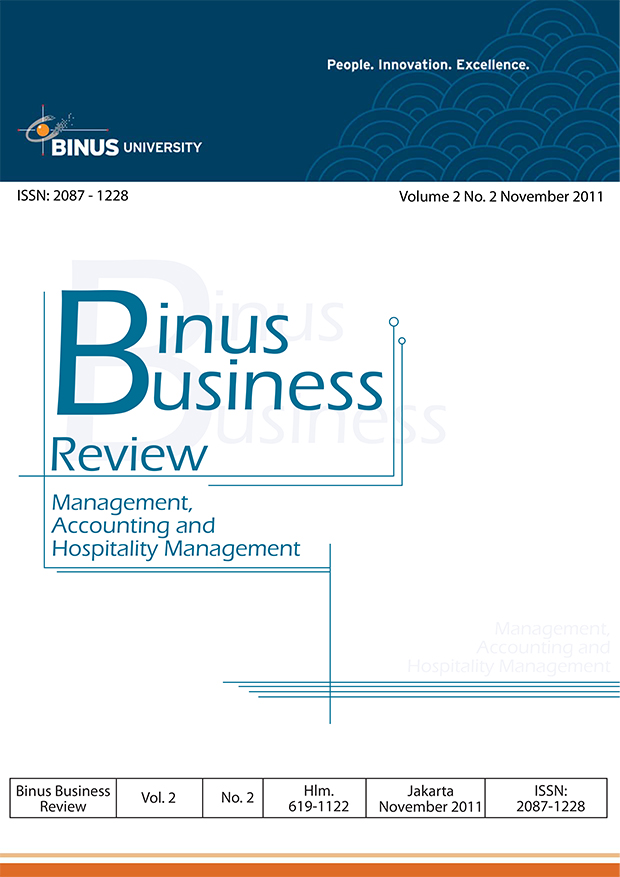Analisis Kinerja Keuangan Bank Sebelum Dan Sesudah Diakuisisi Oleh Investor Asing: Studi Empiris Pada Bank Central Asia Dan Bank Niaga
DOI:
https://doi.org/10.21512/bbr.v2i1.1176Keywords:
CAMELS, profitability analysis, credit analysis, kinerja keuanganAbstract
Banking industry is one of the most influence factors in the economy growth of one country. However, during 1997-1998 Indonesia banking industry went through hard times because of economic crisis. After that years, many banks were liquidated and restructured. The interesting part is through the restructuring process, several bank acquired by foreign investor and became the foreign-domestic bank. In 2010, some of those banks were in the 10 biggest banks in Indonesia based on asset. Hence, the writer interesting to compare the bank’s financial performance before and after being acquired using two banks as samples of empirical study. Data is based on financial statements published by the companies and Central Bank of Indonesia in 1995-1996, and 2003-2004. Two sample of banks have been selected based on several criteria, they are BCA and Bank Niaga. To analyse their financial performance, several analysis tools will be using, specifically CAMELS (CAR, NPL, NIM, BOPO, LDR minus mangement and sensitivity). The result of the study observed that after being acquired, financial performance of BCA and Niaga Bank is getting better in CAR, NIM, BOPO, but NPL and LDR is less favorable for BCA and so NPL is less favorable for Niaga Bank. Moreover, in terms of profitability analysis, both banks shows better performance. While, the result of credit analysis indicates that the credit risk for both banks is in the stable range at CCC.References
Akbarwati, I (2010). Peta perbankan Indonesia berkenaan penerapan API. Diakses tanggal 24 Februari 2011. http://www.managementfile.com/column.php?sub=economy&id=2080&page=economy
Asian Development Bank (2004). Second Development Finance Project (Loan 1223-INO) in Indonesia. http://www.adb.org/Documents/PPARS/INO/ppar-ino-26194.pdf. Diakses tanggal 21 Mei 2011.
Bonin, J. P., Hasan, I., & Wachtel, P. (2003). Bank performance, efficiency and ownership in transition countries. Paper dipresentasikan pada The Ninth Dubrovnik Economic Conference, Hotel Argentina, Dubrovnik, June 26-28, 2003.
Chantapong, S. (2005). Comparative study of domestic and foreign bank performance in thailand: The regression analysis. Economic Change and Restructuring, 38: 63-83.
Farid. (1996). Obligasi RI: MenKeu Tak Risaukan Peringkat S&P. http://www.kompas.com/perubahankondisiekonomi.9607/23/UTAMA/menk.htm. Diakses tanggal 6 Juni 2011.
Kashmir. (2008). Manajemen perbankan (edisi revisi 2008). Jakarta: RajaGrafindo Persada.
Surat Edaran No. 6/23/DPNP tanggal 31 Desember 2004, Tentang Pedoman perhitungan rasio keuangan.
Surat Keputusan Direksi No. 6/10/PBI/2004 tanggal 12 April 2004, Tentang Tata cara penilaian tingkat kesehatan bank umum.
Suta, I. P. G. A., & Soebowo, M. (2003). Membedah krisis perbankan; Anatomi krisis dan penyehatan perbankan. Jakarta: Yayasan SAD Satria Bhakti.
Widioatmodjo, S. (2005). Cara sehat investasi pasar modal. Jakarta: Elex Media Komputindo.
Downloads
Published
How to Cite
Issue
Section
License
Authors who publish with this journal agree to the following terms:
a. Authors retain copyright and grant the journal right of first publication with the work simultaneously licensed under a Creative Commons Attribution License - Share Alike that allows others to share the work with an acknowledgment of the work's authorship and initial publication in this journal.
b. Authors are able to enter into separate, additional contractual arrangements for the non-exclusive distribution of the journal's published version of the work (e.g., post it to an institutional repository or publish it in a book), with an acknowledgment of its initial publication in this journal.
c. Authors are permitted and encouraged to post their work online (e.g., in institutional repositories or on their website) prior to and during the submission process, as it can lead to productive exchanges, as well as earlier and greater citation of published work.
USER RIGHTS
All articles published Open Access will be immediately and permanently free for everyone to read and download. We are continuously working with our author communities to select the best choice of license options, currently being defined for this journal as follows: Creative Commons Attribution-Share Alike (CC BY-SA)





















